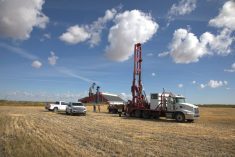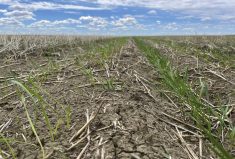As more and more farmers, politicians and laypeople are coming to understand, nutrient run-off from farm fields into waterways is a very big deal.
When not managed properly, nutrients from fertilizer and manure make their way into creeks, lakes, dugouts, and other water bodies. But a new tool to help mitigate phosphorus run-off risk will soon be available.
Over the past three years, Alberta Agriculture and Forestry and the Intensive Livestock Working Group (an alliance of eight of Alberta livestock and poultry organizations) have been collaborating to build a simple, personalized farm management decision-support tool designed to help manage phosphorus run-off. The Alberta Phosphorus Management Tool, expected to be available in late spring, is a free, Excel-based tool for assessing phosphorus run-off risk. The tool will also provide producers with management solutions that include both a relative cost and environmental efficacy ranking.

“The idea behind this tool is to help producers prioritize where they could invest their time, energy and/or resources to manage phosphorus and run-off,” said provincial water research specialist Jennifer Kerr. “Multiple beneficial management practices (BMPs) might be recommended based on a producer’s answers to the questionnaire. Obviously, you can’t necessarily change environmental or geographic factors, but you can change things like how much manure you apply to a field or what time of year cattle have access to a riparian area.”
Based on answers to the producer questionnaire, the tool provides a variety of customized recommendations.
“A producer might choose to implement simple, inexpensive recommendations to address their risk, while other situations may require a more complex solution,” said Kerr. “Compared to doing nothing, even a small change is better.”
Read Also

More precious than gold
When commercial fertilizers no longer meet the needs of the world’s farmers, the value of manure will grow, says Alberta Farmer columnist Brenda Schoepp.
Some recommendations — such as soil testing to determine nutrient levels before applying manure or fertilizer in order to limit overfertilizing — reduce run-off while also saving money.
Over the longer term, the plan is to offer producers additional resources and support to help them best manage run-off. Currently, the project team is putting together a producer website with links to additional tools, information, and resources (including grant opportunities).
Any information provided by farmers will be kept strictly confidential and won’t be shared with other agencies, Kerr said.
“Our priority is all about finding solutions,” she said. “As we were developing this project, we thought about different options and versions of this tool, including the idea of having farmers complete the questionnaire online. But if we went that route, we’d have to be really careful about where any producer information was stored for security reasons. And we know we’d lose some producers’ willingness to complete the tool because they would be concerned their information was tracked.
“So in the end, we designed it as a downloadable document that you save to your own computer, so you have total control over it.”
The tool is also designed to be user friendly and real-world applicable. The questionnaire drop-down menus make completion simple, and all analysis and calculations are completed via the tool’s embedded calculators and algorithms.
To date, the tool has been tested by at least 10 producers in two study watersheds,” said Kerr. “Everything from the questions asked, to the recommendations offered, to the layout and operation of the tool itself have been vetted by and adjusted according to producer feedback.
It’s hoped the tool will be widely used.
“The vast majority of farmers is extremely environmentally conscious,” said Kerr. “For them, choosing to use this tool will be just another aspect of their environmental planning. For those who are slower to respond, they need to consider that social licence is becoming a very important aspect of agricultural producers’ businesses, and environmental stewardship is a key component of that.
“Alternatively, farmers can seek support from agricultural extension staff, agrologists, or others with strong environmental and production understanding to help develop run-off risk mitigation strategies.”
While the Alberta Phosphorus Management Tool won’t be available for a few months, a companion resource guide is available now at www.agriculture.alberta.ca (search for ‘phosphorus management guide’).















